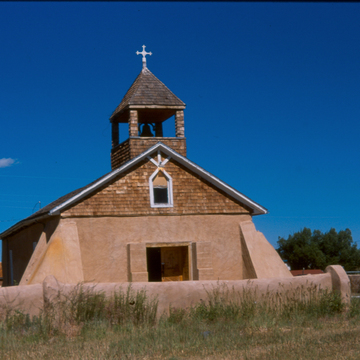This chapel, which has 18-inch-thick adobe walls, is said by some to be older than the “oldest church in Colorado” (in Conejos; CN01). It lies on the southwest corner of what was the old plaza. Like other early churches in the San Luis Valley, this originally had a flat roof supported by vigas 16 inches in circumference. Around 1910 it was replaced with a pitched roof supported by a system of pitched rafters and tie rods. Evidence of the old flat viga roof was discovered during reconstruction in 1989.
A relatively fresh coat of adobe plaster glistens on the bulky composition bolstered by huge buttresses reminiscent of the old adobe church of El Rancho de Taos in New Mexico, made famous by Georgia O'Keeffe's paintings. A shake shingle roof is crowned by an open wooden bell tower with a bronze bell (1910). Painted panels fill one-over-one double-hung windows, with a lancet window in the east gable and a round window in the sacristy on the west. Inside, new peeled log columns and beams support the roof and choir loft. When the floor was replaced in 1990, graves in the earth beneath it were marked to avoid placing any bracing on them. The altar is a raised wooden platform in the apse with a hand-painted reredos (1989) by Maria Romero Cash. The adobe-walled church courtyard and cemetery overlook the tiny village of Viejo San Acacio with its dirt lanes and sparkling water ditches.

